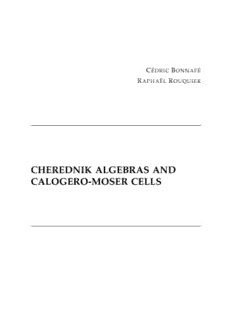
Cherednik algebras and Calogero-Moser cells PDF
Preview Cherednik algebras and Calogero-Moser cells
CÉDRIC BONNAFÉ RAPHAËL ROUQUIER CHEREDNIK ALGEBRAS AND CALOGERO-MOSER CELLS CÉDRIC BONNAFÉ InstitutdeMathématiquesetdeModélisationdeMontpellier(CNRS:UMR5149), UniversitéMontpellier2,CaseCourrier051,PlaceEugèneBataillon,34095 MONTPELLIERCedex,FRANCE. E-mail: [email protected] RAPHAËL ROUQUIER UCLAMathematicsDepartmentLosAngeles,CA90095-1555,USA. E-mail: [email protected] The second author was partially supported by the NSF (grant DMS-1161999) and byagrantfromtheSimonsFoundation(#376202). October26,2016 CHEREDNIK ALGEBRAS AND CALOGERO-MOSER CELLS CÉDRIC BONNAFÉ, RAPHAËL ROUQUIER CONTENTS PartI. Reflectiongroups................................................. 7 1. Notations.............................................................. 9 1.1. Integers............................................................ 9 1.2. Gradings........................................................... 9 1.3. Modules........................................................... 10 2. Reflectiongroups...................................................... 11 2.1. Determinant,roots,coroots.......................................... 11 2.2. Invariants.......................................................... 12 2.3. Hyperplanesandparabolicsubgroups............................... 13 2.4. Irreduciblecharacters............................................... 14 2.5. Hilbertseries....................................................... 15 2.6. Coxetergroups..................................................... 17 PartII. Cherednikalgebras............................................... 19 3. GenericCherednikalgebra............................................. 21 3.1. Structure........................................................... 21 3.2. Gradings........................................................... 27 3.3. Eulerelement....................................................... 29 3.4. Sphericalalgebra................................................... 29 3.5. SomeautomorphismsofH(cid:101).......................................... 31 3.6. SpecialfeaturesofCoxetergroups................................... 33 4. Cherednikalgebrasatt =0............................................. 35 4.1. Generalities........................................................ 35 4.2. Center............................................................. 37 4.3. Localization........................................................ 39 4.4. Complements...................................................... 41 6 C.BONNAFÉ&R.ROUQUIER 4.5. SpecialfeaturesofCoxetergroups................................... 44 Appendices.............................................................. 45 A. Filtrations............................................................. 47 A.1. Filteredmodules................................................... 47 A.2. Filteredalgebras................................................... 47 A.3. Filteredmodulesoverfilteredalgebras............................... 48 A.4. Symmetricalgebras................................................ 50 A.5. Weylalgebras...................................................... 51 B. Invariantrings........................................................ 53 B.1. Moritaequivalence................................................. 53 B.2. Geometricsetting................................................... 54 Bibliography............................................................. 57 PART I REFLECTION GROUPS CHAPTER 1 NOTATIONS 1.1. Integers Weput(cid:78)=(cid:90)(cid:190)0. 1.2. Gradings 1.2.A. Let k be a ring and X a set. We denote by kX =k(X) the free k-module with basis X. We sometimes denote elements of kX as formal sums: (cid:80) α x, where x∈X x α ∈k. x 1.2.B. Let Γ be a monoid. We denote by kΓ (or k[Γ]) the monoid algebra of Γ over k. ItsbasisofelementsofΓisdenotedby{tγ}γ∈Γ. A Γ-graded k-module is a k-module L with a decomposition L = (cid:76)γ∈ΓLγ (that is the same as a comodule over the coalgebra kΓ). Given γ ∈ Γ, we denote by L〈γ 〉 0 0 the Γ-graded k-module given by (L〈γ0〉)γ = Lγγ0. We denote by k-freeΓ the additive category of Γ-graded k-modules L such that Lγ is a free k-module of finite rank for allγ∈Γ. Given L∈k-freeΓ,weput (cid:88) dimΓk(L)= rankk(Lγ)tγ∈(cid:90)Γ. γ∈Γ We have defined an isomorphism of abelian groups dimΓ : K (k-freeΓ)−∼→(cid:90)Γ. This k 0 construction provides a bijection from the set of isomorphism classes of objects of k-freeΓ to (cid:78)Γ. Given P =(cid:80)γ∈Γpγtγ with pγ∈(cid:78), we define the Γ-graded k-module kP by(kP)γ=kpγ. WehavedimΓ(kP)=P. k Wesaythatasubset E ofaΓ-gradedmodule L ishomogeneousifeveryelementof E isasumofelementsin E ∩Lγ forvariouselementsγ∈Γ. 1.2.C. A graded k-module L is a (cid:90)-graded k-module. We put L+ =(cid:76)i>0Li. If Li =0 for i (cid:28)0 (for example, if L is (cid:78)-graded), then dim(cid:90)(L) is an element of the ring of k 10 Laurent power series (cid:90)((t)): this is the Hilbert series of L. Similarly, if L = 0 for i i (cid:29)0,thendim(cid:90)(L)∈(cid:90)((t−1)). k When L has finite rank over k, we define the weight sequence of L as the unique sequenceofintegersr1(cid:182)···(cid:182)rm suchthatdim(cid:90)k(L)=tr1+···+trm. A bigraded k-module L is a ((cid:90)×(cid:90))-graded k-module. We put t=t(1,0) and u=t(0,1), sothatdim(cid:90)×(cid:90)(L)=(cid:80) dim (L )tiuj for L∈k-free(cid:90)×(cid:90). When L is((cid:78)×(cid:78))-graded,we k i,j k i,j havedim(cid:78)×(cid:78)(L)∈(cid:90)[[t,u]]. k 1.2.D. Assume k is a commutative ring. There is a tensor product of Γ-graded k- modulesgivenby(L⊗kL(cid:48))γ=(cid:76)γ(cid:48)γ(cid:48)(cid:48)=γLγ(cid:48)⊗kLγ(cid:48)(cid:48). Whenthefibersofthemultiplication map Γ×Γ→Γ are finite, the multiplication in Γ provides (cid:90)Γ with a ring structure, thetensorproductpreservesk-freeΓ,anddimΓ(L⊗ L(cid:48))=dimΓ(L)dimΓ(L(cid:48)). k k k k AΓ-gradedk-algebraisak-algebraA withaΓ-gradingsuchthatAγ·Aγ(cid:48) ⊂Aγγ(cid:48). 1.3. Modules Let A be a ring. Given L a subset of A, we denote by < L > the two-sided ideal of A generated by L. Given M an A-module, we denote by Rad(M) the intersection of the maximal proper A-submodules of M. We denote by A-mod the category of finitely generated A-modules and we putG (A)=K (A-mod), where K ((cid:67)) denotes 0 0 0 theGrothendieckgroupofanexactcategory(cid:67). Given M ∈ A-mod, we denote by [M] (or simply [M]) its class in G (A). When A 0 A is a graded ring and M is a finitely generated graded A-module, we denote by [M]gr (or simply [M]gr) its class in the Grothendieck group of the category A-modgr A of finitely generated graded A-modules. Note that K (A-modgr) is a (cid:90)[t±1]-module, 0 witht[M]gr=[M〈−1〉]gr. We denote by Irr(A) the set of isomorphism classes of simple A-modules. As- sume A is a finite-dimensional algebra over the field k. We have an isomorphism ∼ (cid:90)Irr(A)−→G (A), M (cid:55)→[M]. If A is semisimple, we have a bilinear form 〈−,−〉 on 0 A G (A)givenby〈[M],[N]〉=dim Hom (M,N). WhenA issplitsemisimple,Irr(A)pro- 0 k A videsanorthonormalbasis. Let W be a finite group and assume k is a field. We denote by Irr (W) (or simply k by Irr(W)) the set of irreducible characters of W over k. When |W|∈k×, there is a ∼ bijection Irrk(W)−→Irr(kW), χ (cid:55)→ Eχ. The group Hom(W,k×) of linear characters of W withvaluesinkisdenotedbyW∧k (orW∧). WehaveanembeddingW∧⊂Irr(W), and equality holds if and only if W is abelian and k contains all e-th roots of unity, where e istheexponentofW.
